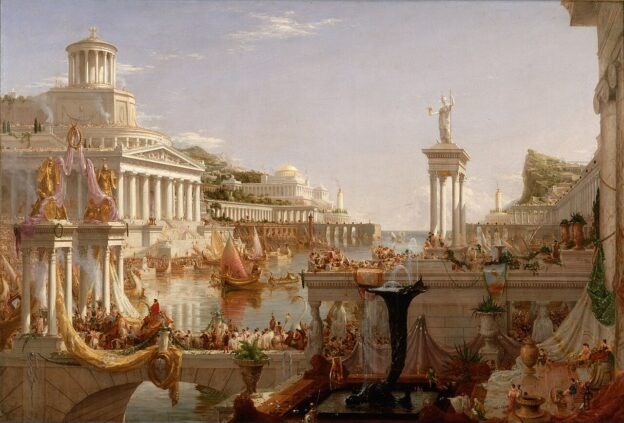Volume III of Edward Gibbon’s magisterial “The Decline and Fall of the Roman Empire” delves into the bifurcated Roman world: the Western Roman Empire with Rome at its heart, and the Eastern Roman Empire, later known as Byzantium, with its capital in Constantinople. In this volume, Gibbon artfully weaves a narrative that spans wars, religious schisms, and the ultimate fall of the Western Roman Empire. This essay seeks to illuminate the salient themes and scholarly insights presented in this volume, elucidating Gibbon’s masterful treatment of a pivotal epoch in Roman history.
The Dichotomy of East and West
At the outset of Volume III, Gibbon meticulously delineates the contrasting fortunes of the Western and Eastern Roman Empires. While both empires shared a common heritage, their divergent geopolitical realities, administrative choices, and cultural trajectories rendered them increasingly distinct entities.
The Eastern Empire, with its strategic location in Constantinople, was better poised to manage external threats, drawing wealth from trade routes and enjoying the proximity to the rich eastern provinces. The Western Empire, on the other hand, was beleaguered by barbarian invasions, internal strife, and economic challenges.
Gibbon’s portrayal serves as a cautionary tale of how the vagaries of geography, leadership, and external pressures can shape the fortunes of empires.
The Gothic War and the Tumult of the West
One of the central narratives in Volume III is the Gothic War. Gibbon chronicles the Gothic tribes’ migration and their tumultuous relationship with the Roman Empire, culminating in the sack of Rome in 410 AD. His account underscores the complexities of this relationship: the Goths, initially foederati or allies of the empire, would eventually become its adversaries.
Gibbon’s narration is not merely military; he delves into the socio-cultural implications of the Gothic presence in the empire, highlighting how the integration and eventual alienation of such groups had lasting repercussions on the Western Empire’s fabric.
Christianity’s Evolving Landscape
Gibbon’s examination of the Christian church and its schisms is both detailed and critical. He charts the evolving theological landscape of Christianity, from the Donatist controversy to the Nestorian schism. The theological disputes, as presented by Gibbon, are not mere doctrinal quarrels but deeply political maneuvers, reflecting the broader tensions within the empire.
The Councils, the debates, and the subsequent excommunications all serve as windows into an empire grappling with its religious identity, further complicating its already intricate political landscape.
The Denouement: Fall of the Western Roman Empire
Volume III reaches its somber climax with the fall of the Western Roman Empire in 476 AD. Gibbon’s portrayal of this watershed moment is both dramatic and reflective. The deposition of Romulus Augustulus, the last Roman emperor of the West, symbolizes the end of an epoch.
Yet, Gibbon is careful to nuance his narrative. He underscores that while 476 AD is conventionally marked as the ‘end’ of the Western Roman Empire, its decline was gradual, shaped by multifarious factors over centuries. It serves as a poignant reminder of the transience of power and the inexorable march of time.
Conclusion
In Volume III of his opus, Edward Gibbon presents a Roman world in flux, marked by division, war, theological ferment, and decline. Through his erudite prose, he invites readers to traverse the corridors of power in Rome and Constantinople, to witness the debates in ecclesiastical councils, and to stand amidst the Goths as they gaze upon a fallen Rome. It is a volume that, while chronicling the end of ancient Rome, also beckons scholars to reflect on the cyclical nature of history, where empires rise, flourish, and inevitably, fade.
